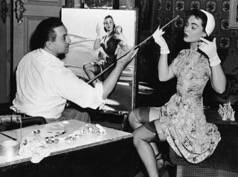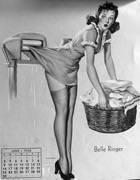
Naughty but Nice: Commercial Illustrator Gillette Elvgren
Appeared in The Gazette, Spring/Summer 2020
by Helen Weaver
For 15 years from the early 1940s until the late 1950s, Winnetka was the home base of Gillette (Gil) Elvgren, a highly successful commercial artist, best known for his paintings of scantily clad women published in advertising calendars for the Brown & Bigelow Company. Elvgren, his wife Janet and their children Karen, Gil Jr., and Drake, lived in a rented house on Foxdale from 1941-1951. The Elvgrens then bought a French Provincial house at 1153 Pine Street, designed by Russell S. Walcott in 1920. Elvgren converted the attic into a studio and painted more than 20 paintings a year there until 1956 when the family moved to Florida.

Some WWII bomber pilots used this 1940s
era Elvgren pin-up as inspiration for airplane nose art.
Born and raised in St. Paul, Minnesota, Elvgren came to Chicago in 1933 after eloping with his childhood sweetheart, Janet Cummins. He attended the American Academy of Art, graduating early after just two years.
In 1937, Elvgren got his first big break when the Louis F. Dow Company hired him to paint a collection of “pin-ups.” His subject was the girl-next-door caught in a compromising position and thus naughty, but still nice. Her skirt was accidentally blown up by the wind, tugged by a dog, or caught on a fence to reveal a little extra leg and a garter.
These Dow pin-ups became popular collectibles when they were reprinted and marketed to soldiers overseas during World War II. Many amateur artists reproduced Elvgren’s images on aircraft noses and flight jackets.
As the advertising industry in Chicago was beginning to boom, the Stevens-Gross Studio offered Elvgren a staff position in 1940. He produced work for numerous commercial clients including Coca- Cola, Ovaltine, Ford, Sylvania Electric, Serta Mattress, and others. Elvgren’s advertisements appeared in the Saturday Evening Post, Cosmopolitan, McCall’s, Redbook, and Woman’s Home Companion.
He painted many of the iconic “Coke Girls” seen on billboards and in magazines throughout the 1940s and 50s. He also did work in support of the war effort in ads for clients like Swift Meats and General Electric.

Elvgren produced many “Coke Girl” images during a 25-year span representing the Coca-Cola Company.
In 1944, calendar publisher Brown & Bigelow hired Elvgren to produce 24 calendar pin-up paintings a year for $1,000 a painting. This made him, according to biographer Charles Martignette, “one of the highest paid illustrators in America.”
Elvgren continued to do work for other commercial clients, including Coca-Cola with whom he had a 25-year partnership. One of his later clients was Napa Auto Parts whose calendar girls were similarly beautiful, but with more modest attire.
Elvgren was also a talented photographer and always painted from posed photos that he himself had taken. Models would come to his studio and be posed in elaborate situations to mimic the pin-up scene Elvgren had in mind. He preferred to work with younger inexperienced models. In a book he co-authored, Elvgren: His Life & Art, son Drake Elvgren remembers: “He wanted a cute girl-next-door, the approachable girl — cute was more important than beautiful.”
One of Elvgren’s favorite models was Chicago high school student Myrna Hansen. She posed for more than 20 paintings, including several Brown & Bigelow pinups as well as universal billboard paintings that Elvgren produced for the Schmidt Lithography Company.
Hansen started to work with Elvgren at the age of 15 and even wore her own prom dress to pose for a painting. In 1953, Hansen won the Miss USA contest and was runner-up for Miss Universe. She went on to have a career in Hollywood as a film actress.
The most famous model to work with Elvgren was Kim Novak, who was born in Chicago in 1933.
While some viewers might consider Elvgren’s pin-up paintings risqué, compared to some modern advertising, they are fairly tame. In a 2005 Chicago Tribune article, book editor Dian Taschen described Elvgren’s style: “He was the master of the forbidden peek. You got a sense that you were catching something that you weren’t supposed to . . . almost as if the girl was conspiring with the wind to have her skirt blow up.”
In the same article, pin-up historian Greg Theakston added: ”It’s cute; it’s not meant to bash you over the head with sexuality. It’s supposed to titillate you.” A blogger on Coke art at wordpress.com puts it this way: “Elvgren conveys the ideal of real life, fun, beauty, and sensuality in every one of his paintings. Never sexual, always sensual, their style is the epitome of the age of elegance in which he lived.”
Elvgren’s career continued successfully though the early 1960s, but as magazines turned to full-color photo illustrations, the type of art Elvgren specialized in was no longer in vogue. He died in 1980 at the age of 65. In the late 1990s, several books on pin-up art in general and Gillette Elvgren’s work in particular have brought some acclaim to this illustrator. Today he is recognized as one of the most important glamour artists of the 20th century.

No comments yet.